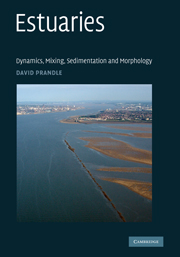Book contents
- Frontmatter
- Contents
- List of symbols
- 1 Introduction
- 2 Tidal dynamics
- 3 Currents
- 4 Saline intrusion
- 5 Sediment regimes
- 6 Synchronous estuaries: dynamics, saline intrusion and bathymetry
- 7 Synchronous estuaries: sediment trapping and sorting – stable morphology
- 8 Strategies for sustainability
- Index
- References
5 - Sediment regimes
Published online by Cambridge University Press: 01 September 2009
- Frontmatter
- Contents
- List of symbols
- 1 Introduction
- 2 Tidal dynamics
- 3 Currents
- 4 Saline intrusion
- 5 Sediment regimes
- 6 Synchronous estuaries: dynamics, saline intrusion and bathymetry
- 7 Synchronous estuaries: sediment trapping and sorting – stable morphology
- 8 Strategies for sustainability
- Index
- References
Summary
Introduction
Understanding and predicting concentrations of suspended particulate matter (SPM) in estuaries are important because of their impact on (i) light occlusion and thereby primary production, (ii) pathways for adsorbed contaminants and (iii) rates of accretion and erosion and associated bathymetric evolution.
Sediments are traditionally classified according to their (mass equivalent) particle diameter, d, with sizes ranging from clay <4 μ, 4 μ < silt < 63 μ, 63 μ < sand < 1000 μ through to gravel and rocks. Importantly, the silt–sand demarcation separates cohesive (mutual attraction by electro-chemical forces) from non-cohesive sediments. In higher concentrations, the former tend to flocculate into multiple assemblages which can both settle more rapidly and inhibit the upward flux of turbulent energy from the sea bed (Krone, 1962). In extreme cases, a layer of liquid mud may form a two-phase flow continuum. Moreover, once deposited, consolidation of cohesive material can radically change re-erosion rates. Only a few percent of ‘mud’ content may strongly influence what might appear to be a cohesionless sandy bed (Winterwerp and van Kesteren, 2004).
Over millennia, the inter-glacial rise and fall of sea level effectively determines estuarine morphology. Over shorter time scales, of interest to coastal engineers and coastal planners, some quasi-equilibria develop encompassing variations in bathymetry over ebb to flood and spring to neap tides, alongside seasonal cycles, random storms and episodic extreme events.
- Type
- Chapter
- Information
- EstuariesDynamics, Mixing, Sedimentation and Morphology, pp. 123 - 150Publisher: Cambridge University PressPrint publication year: 2009



